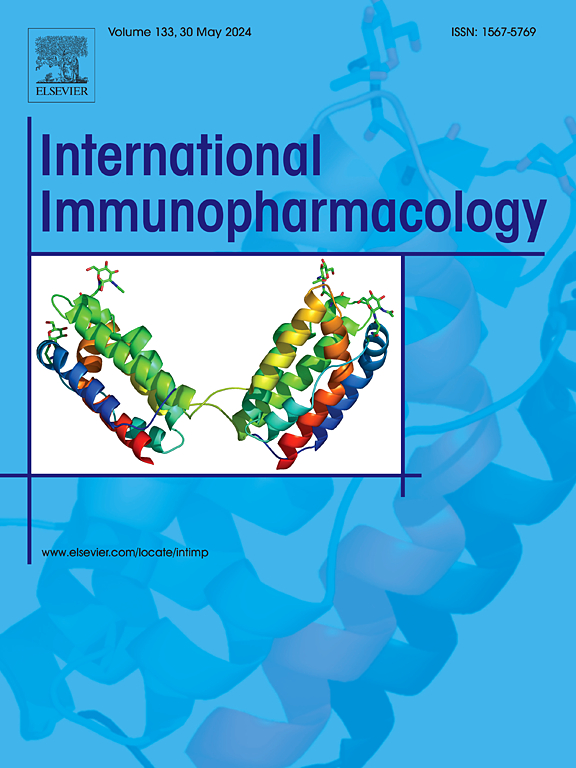Kaempferol attenuates experimental autoimmune neuritis through TNFR1/JNK/p38 signaling pathway inhibition
IF 4.8
2区 医学
Q2 IMMUNOLOGY
引用次数: 0
Abstract
Kaempferol (Kae) is a flavonoid that has antioxidant, anti-inflammatory and neuroprotective effects. In recent years, there have been increasing reports on viral infection-induced Guillain-Barré syndrome (GBS) with high rates of disability and fatality. Therefore, in order to search for effective peripheral nerve injury repair drugs, we used rats with experimental autoimmune neuritis (EAN) as the typical animal model for GBS, and implemented Kae treatment intervention on EAN rats. Real-time quantitative polymerase chain reaction (qPCR), western blotting (WB) and immunofluorescence (IF) were utilized to detect the changes of inflammatory factors and signaling pathway proteins in peripheral nerve of rats. The impact of Kae on peripheral nerve damage in EAN rats was evaluated in multiple dimensions by clinical symptom score and neuroelectrophysiology examination, and the protective impact and mechanism of Kae on peripheral nerve injury were revealed. Our results showed that Kae increased the expression of sciatic myelin basic protein (MBP), decreased the expression of peripheral nerve macrophage infiltration and inflammatory cytokines, including TNF-α, IL-1β and IL-6, and down-regulated the expression levels of TNFR1. Additionally, it suppressed the activation of the JNK and p38 pathways. It can alleviate sciatic nerve symptoms and pathological injury in EAN rats. Therefore, we believe that Kae can be used as an adjunct drug in the treatment of GBS.
山奈酚通过抑制TNFR1/JNK/p38信号通路减轻实验性自身免疫性神经炎。
山奈酚(Kae)是一种类黄酮,具有抗氧化、抗炎和神经保护作用。近年来,关于病毒感染引起的高致残率和致死率的格林-巴- 综合征(GBS)的报道越来越多。因此,为了寻找有效的周围神经损伤修复药物,我们将实验性自身免疫性神经炎(EAN)大鼠作为GBS的典型动物模型,对EAN大鼠进行Kae治疗干预。采用实时定量聚合酶链反应(qPCR)、免疫印迹法(WB)和免疫荧光法(IF)检测大鼠周围神经炎症因子和信号通路蛋白的变化。通过临床症状评分和神经电生理检查,从多个维度评价凯对EAN大鼠周围神经损伤的影响,揭示凯对周围神经损伤的保护作用及其机制。我们的研究结果显示,Kae增加了坐骨髓鞘碱性蛋白(MBP)的表达,降低了周围神经巨噬细胞浸润和炎症因子TNF-α、IL-1β和IL-6的表达,下调了TNFR1的表达水平。此外,它抑制JNK和p38通路的激活。可减轻EAN大鼠坐骨神经症状及病理性损伤。因此,我们认为Kae可以作为治疗GBS的辅助药物。
本文章由计算机程序翻译,如有差异,请以英文原文为准。
求助全文
约1分钟内获得全文
求助全文
来源期刊
CiteScore
8.40
自引率
3.60%
发文量
935
审稿时长
53 days
期刊介绍:
International Immunopharmacology is the primary vehicle for the publication of original research papers pertinent to the overlapping areas of immunology, pharmacology, cytokine biology, immunotherapy, immunopathology and immunotoxicology. Review articles that encompass these subjects are also welcome.
The subject material appropriate for submission includes:
• Clinical studies employing immunotherapy of any type including the use of: bacterial and chemical agents; thymic hormones, interferon, lymphokines, etc., in transplantation and diseases such as cancer, immunodeficiency, chronic infection and allergic, inflammatory or autoimmune disorders.
• Studies on the mechanisms of action of these agents for specific parameters of immune competence as well as the overall clinical state.
• Pre-clinical animal studies and in vitro studies on mechanisms of action with immunopotentiators, immunomodulators, immunoadjuvants and other pharmacological agents active on cells participating in immune or allergic responses.
• Pharmacological compounds, microbial products and toxicological agents that affect the lymphoid system, and their mechanisms of action.
• Agents that activate genes or modify transcription and translation within the immune response.
• Substances activated, generated, or released through immunologic or related pathways that are pharmacologically active.
• Production, function and regulation of cytokines and their receptors.
• Classical pharmacological studies on the effects of chemokines and bioactive factors released during immunological reactions.
文献相关原料
公司名称
产品信息
索莱宝
HE
阿拉丁
Kaempferol powder

 求助内容:
求助内容: 应助结果提醒方式:
应助结果提醒方式:


